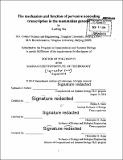The mechanism and function of pervasive noncoding transcription in the mammalian genome
Author(s)
Wu, Xuebing, Ph. D. Massachusetts Institute of Technology
DownloadFull printable version (19.89Mb)
Other Contributors
Massachusetts Institute of Technology. Computational and Systems Biology Program.
Advisor
Phillip A. Sharp and Christopher B. Burge.
Terms of use
Metadata
Show full item recordAbstract
The vast majority of the mammalian genome does not encode proteins. Only 2% of the genome is exonic, yet recent deep survey of human transcripitome suggested that 75% of the genome is transcribed, including half of the intergenic regions. Such pervasive transcription typically leads to short-lived, low-copy number noncoding RNAs (ncRNAs). We are starting to understand the biogenesis and mechanisms regulating the noncoding transcription. However, it is still unclear what's the functional impact of pervasive transcription and the ncRNAs at the level of the'genome, the cell, and the organism. A large fraction of ncRNAs in cells is generated by divergent transcription that occurs at the majority of mammalian gene promoters. RNA polymerases transcribe divergently on opposite strands, producing precursor mRNAs (pre-mRNAs) on one side and promoter upstream antisense RNAs (uaRNAs) on the other side. Like typical products of pervasive transcription, uaRNAs are relatively short and unstable as compared to pre-mRNAs, suggesting there are mechanisms suppressing uaRNA transcription and enforcing promoter directionality. We describe the Ul-PAS axis, a mechanism that enhances gene transcription but suppresses noncoding transcription. Two RNA processing signals, the Ul signal, or 5' splice site sequences recognized by Ul snRNP during splicing, and polyadenylation signal (PAS), differentially mark the two sides of gene transcription start site (TSS), ensuring the generation of full-length mRNA but inducing early termination of uaRNAs. The Ul-PAS axis also suppresses pervasive transcription on the antisense strand of genes, as well as intergenic transcription. Transcription is a mutagenic process that could accelerate evolution. We uncover a link between pervasive transcription and genome evolution. Specifically, transcription-induced mutational bias in germ cells could strengthen the Ul-PAS axis, which in turn enhances transcription, thus forming a positive feedback loop, which eventually drives new gene origination, and facilitates genome rearrangements. Tools to directly interfere with transcription with specificity are necessary to understand the function of noncoding transcription, especially when the RNA product is rapidly degraded or nonfunctional. The newly emerged CRISPR-Cas9 system provides the opportunity to target any desired locus. We comprehensively characterize the binding specificity of Cas9 in the mouse genome. We find that Cas9 specificity varies dramatically but in a predictable manner, depending on the seed sequence and chromatin accessibility. Our results will facilitate Cas9 target design and enable genome manipulation with high precision.
Description
Thesis: Ph. D., Massachusetts Institute of Technology, Computational and Systems Biology Program, 2014. Cataloged from PDF version of thesis. Includes bibliographical references
Date issued
2014Department
Massachusetts Institute of Technology. Computational and Systems Biology ProgramPublisher
Massachusetts Institute of Technology
Keywords
Computational and Systems Biology Program.